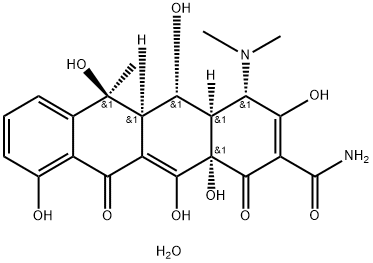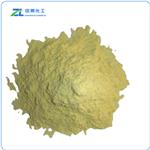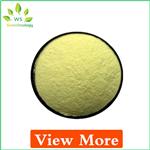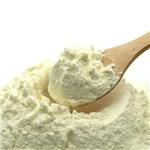Description
Oxytetracycline is an important member of the bacterial aromatic polyketide family, which is a structurally diverse class of natural products. It's a prescription antibiotic that interferes with bacteria's ability to produce essential proteins.
Synthesis
Oxytetracycline dihydrate is synthesized by a type II polyketide synthase that generates the poly-beta-ketone backbone through successive decarboxylative condensation of malonyl-CoA extender units, followed by modifications by cyclases, oxygenases, transferases, and additional tailoring enzymes.
Chemical Properties
yellow crystalline powder
Uses
Antibiotic substance isolated from the elaboration products of the actinomycete, Streptomyces rimosus, grown on a suitable medium. Antibacterial.
brand name
Terramycin (Pfizer).
General Description
Oxytetracycline was found in the culture broth of Streptomyces rimosus by Pfizer in 1950 and named terramycin. It is closely related to chlortetracycline (aureomycin), and its structure was elucidated in 1952. Oxytetracycline has had wide clinical use as a substitute for chlortetracycline, even after the introduction of tetracycline. Oxytetracycline is administered orally, topically, and parenterally.
Purification Methods
Terramycin crystallises (as dihydrate) from water or aqueous EtOH and is soluble in MeOH, EtOH, Me2CO and H2O (0.25mg/mL at 25o ) but insoluble in Et2O and pet ether. It is amphoteric, and an aqueous solution has pH 2.0-5.0. It has max at 247, 275 and 353nm in 0.1 M phosphate (pH 4.5). [Finlay et al. Science 111 85 1951.] The hydrochloride, [2058-46-0] M 496.9 [Beilstein 14 IV 2630], crystallises from MeOH in needles and from H2O at 50o it forms plates. Terramycin has also been purified via the hydrochloride by dissolving it in H2O, adjusting to pH 6, and the solid is filtered off after 1hour. The crystals of the dihydrate are dried to constant weight in vacuum/CaCl2/25o. Drying at 60o in vacuo gives the anhydrous base m 184.5-185.5o (sintering at 180o). The dihydrate has m 181-182o. Its optical rotation in MeOH decreases from [] D 25 +26o (c 0.5%) to [] D 25 +11.3o after standing for 16hours. It forms a sodium salt and a CaCl2 complex. [Regna et al. J Am Chem Soc 73 4211 1951, Beilstein 14 IV 2633.]





